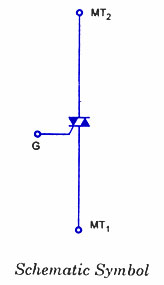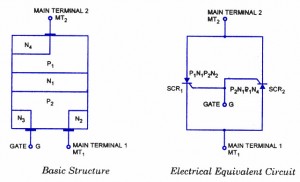Introduction to Triac-Its construction and Operation
The triac is another three-terminal ac switch that is triggered into conduction when a low-energy signal is applied to its gate terminal. Unlike the SCR, the triac conducts in either direction when turned on. The triac also differs from the SCR in that either a positive or negative gate signal triggers it into conduction. Thus the triac is a three terminal, four layer bidirectional semiconductor device that controls ac power whereas an SCR controls dc power or forward biased half cycles of ac in a load. Because of its bidirectional conduction property, the triac is widely used in the field of power electronics for control purposes. Triacs of 16 kW rating are readily available in the market.
“Triac” is an abbreviation for three terminal ac switch. ‘Tri’-indicates that the device has three terminals and ‘ac’ indicates that the device controls alternating current or can conduct in either direction.

Construction of a Triac
As mentioned above, triac is a three terminal, four layer bilateral semiconductor device. It incorporates two SCRs connected in inverse parallel with a common gate terminal in a single chip device. The arrangement of the triac is shown in figure. As seen, it has six doped regions. The gate terminal G makes ohmic contacts with both the N and P materials. This permits trigger pulse of either polarity to start conduction. Electrical equivalent circuit and schematic symbol are shown in figure.b and figure.c respectively. Since the triac is a bilateral device, the term “anode” and “cathode” has no meaning, and therefore, terminals are designated as main terminal 1. (MT1), main terminal 2 (MT2) and gate G. To avoid confusion, it has become common practice to specify all voltages and currents using MT1 as the reference.

Operation and Working of a Triac
Though the triac can be turned on without any gate current provided the supply voltage becomes equal to the breakover voltage of the triac but the normal way to turn on the triac is by applying a proper gate current. As in case of SCR, here too, the larger the gate current, the smaller the supply voltage at which the triac is turned on. Triac can conduct current irrespective of the voltage polarity of terminals MT1 and MT2 with respect to each other and that of gate and terminal MT2. Consequently four different possibilities of operation of triac exists. They are:
1. Terminal MT2 and gate are positive with respect to terminal MT1
When terminal MT2 is positive with respect to terminal MT1 current flows through path P1-N1-P2-N2. The two junctions P1-N1 and P2-N2 are forward biased whereas junction N1 P2 is blocked. The triac is now said to be positively biased.
A positive gate with respect to terminal MT1 forward biases the junction P2-N2 and the breakdown occurs as in a normal SCR.
2. Terminal MT2 is positive but gate is negative with respect to terminal MT1
Though the flow path of current remains the same as in mode 1 but now junction P2-N3 is forward biased and current carriers injected into P2 turn on the triac.
3.Terminal MT2 and gate are negative with respect to terminal MT1
When terminal MT2 is negative with respect to terminal MT1, the current flow path is P2-N1-P1-N4. The two junctions P2-N1 and P1 – N4 are forward biased whereas junction N1-P1 is blocked. The triac is now said to be negatively biased.
A negative gate with respect to terminal MT1 injects current carriers by forward biasing junction P2-N3 and thus initiates the conduction.
4. Terminal MT2 is negative but gate is positive with respect to terminal MT1
Though the flow path of current remains the same as in mode 3 but now junction P2-N2 is forward biased, current carriers are injected and therefore, the triac is turned on.
Generally, trigger mode 4 should be avoided especially in circuits where high di/dt may occur. The sensitivity of triggering modes 2 and 3 is high and in case of marginal triggering capability negative gate pulses should be used. Though the triggering mode 1 is more sensitive compared to modes 2 and 3, it requires a positive gate trigger. However, for bidirectional control and uniform gate trigger modes 2 and 3 are preferred.
RELATED POSTS

2 Comments
want to be member of electronic Circuit lab
ok